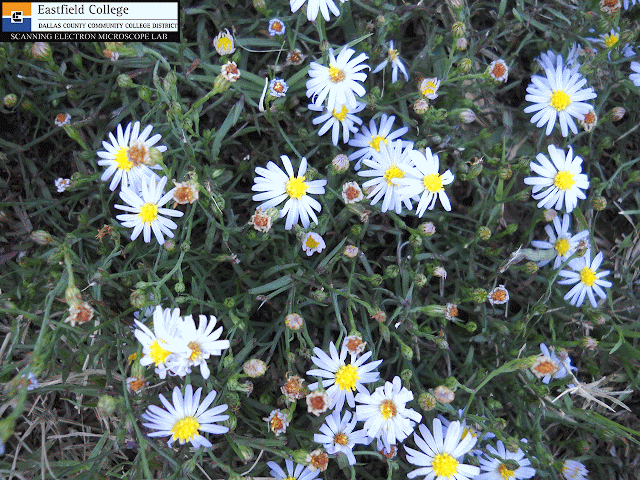The biology professors here at
Eastfield College often take their students into the field. Professor Ron Beecham took a group of students to
Gus Engeling Wildlife Management Area last weekend and brought some samples back to the lab for me to image. One of these is a bee fly - genus
Bombylius.
This little guy is easily recognizable as a fly because it possess a single pair of wings and a pair of halteres - reduced wing stubs that are thought to act as counterbalances. In fact, the order for flies is
diptera, which literally means "two wings". ("di-" is pair and "ptera" is wing.)
Dissecting Scope Image - Ventral View
Note the long tongue
Dissecting Scope Image - Ventral View
The haltere on the left side of the fly appears as a yellowish blob due to the limited depth of field of the camera on the scope.
Dissecting Scope Image
Dorsal View
As I examined this guy, I noticed a tuft of some "hairs" on the leading edge of the wing near the body. This tuft if visible in the following two images.
Dissecting Scope Image
Tuft of hairs on right wing, near body.
Dissecting Scope Image
A closer look at tufts of hairs on right wing.
Now for a head-on view of the fly. The multiple facets of the ommatidia that make up the compound eye are obvious, as are the antennae.
Dissecting Scope Image
Now on to the Scanning Electron Microscope. Here is pretty much the same pose and you can see the advantages, and single disadvantage, of scanning electron microscopy. The only disadvantage with the SEM is loss of color since we are using a beam of electrons instead of light. Not much of a disadvantage at all as far as I am concerned. One big advantage, which is very obvious when comparing the image above with the one below, is the depth of field. On the top image I focused on the upper surface of the eyes - the rest of the image is out of focus. Below you can see that much more of the specimen is in focus.
Head shot
25x

Head shot
37x
My, what beautiful eyes you have!
Right eye
85x
Ommatidia of the compound eye - 20 micros across
267x
Antenna
Note the pores
160x
The next series of images are of the haltere, or reduced second pair of wings.
Haltere
60x
Close-up of haltere - everything has structure
170x
(I realize as I am labeling this image that I missed an opportunity. Is the structure on the haltere similar to that on the wings of the insect? A question needing an answer - sounds like an opportunity for someone to do some science.)
As you may have noticed, this little fly has a very long tongue. Let's see what it looks like
Tongue
80x
At a higher magnification you can see some pollen grains that are stuck to the tongue.
98x
Pollen grains and tongue structure
From the scale bar you can see that the pollen grains are between 30 and 35 microns in diameter.
394x
Tip of the tongue
145x
Tip of the tongue
447x
As I was imaging the tongue I noticed some interesting structures on the legs of the fly. They appear to be covered with scales very similar to those found on butterflies. This may be normal, but being new to SEM work, it definitely surprised me.
Tongue in foreground, leg with scales behind
140x
Leg with spines
50x
Leg joint showing scales and fine structure of spines
190x
Science is all about making observations, asking questions, and then finding out the answers to those questions. What is the function of scales - on flies and butterflies? Is it possible they have some aerodynamic effect?
Now a look at the wings.
Wing
Note the "hairy" structure on the leading edge of the wing at the top of the image.
27x
The tufts of "hair" are actually spines and scales.
65x
Scales and spines on leading edge of the wing.
182x
Eastfield College makes it Scanning Electron Microscope lab available to students and faculty at all levels. If you would like to see or use our SEMs (we have two) please contact me. Our smaller SEM is portable and can be brought to your school for students to use. I know, it sounds like a sales pitch, but for high schools, middle schools, and elementary schools there is not cost.
Our lab is also open for visits - bring your classes. I also Skype!
Murry Gans
Scanning Electron Microscope Lab Coordinator
Eastfield College
Mesquite, TX




































































